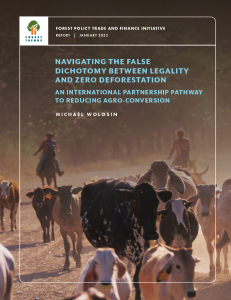Navigating the False Dichotomy Between Legality and Zero Deforestation
An International Partnership Pathway to Reducing Agro-conversion
By Michael Wolosin View PublicationDeforestation and other natural ecosystem loss are wreaking havoc on the climate, on biodiversity, on human rights, and on ecosystem resilience across the tropics. About 60 percent of recent tropical forest loss was caused by commercial agriculture. At least 69 percent of this agro-conversion was illegal.
A diverse set of global strategies has advanced over the past two decades to reduce commodity-driven deforestation. While there have been some successes and lessons learned, the overall global picture is disheartening. Deforestation and agriculture-driven deforestation both continue to increase. Together, we must reverse these trends as quickly as possible.
In this Commentary, Forest Trends outlines a pathway to achieving this critical pivot away from agro-conversion and towards a nature-positive global food and land-use system. We also outline a broader set of related strategies to support forest countries on the pathway to zero agro-conversion, including a particular focus on incentives from the international community to support land-use regulatory frameworks in forest countries that eliminate forest loss entirely.
Related Resources
Illicit Harvest, Complicit Goods (Forest Trends, 2021)
Getting the “Bads” Out of Goods: Evolution from voluntary to regulated approaches in reducing the undesirable impacts of global trade (Forest Trends, 2018)
Consumer Goods and Deforestation (Forest Trends, 2014)
Economic impacts of illegal agro-conversion in tropical forested countries (Forest Trends, 2018)
Tackling Deforestation and Trade in Forest-Risk Commodities: Consumer country measures and the “legality approach” (Forest Trends, 2019)
Supplemental Materials
Figure | Why Legality and Zero-Deforestation Approaches are Complementary


